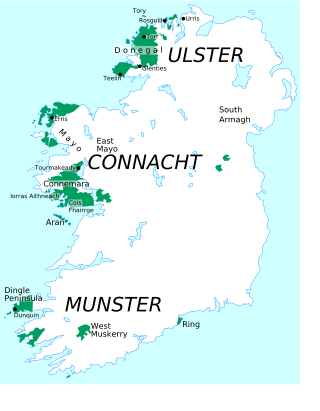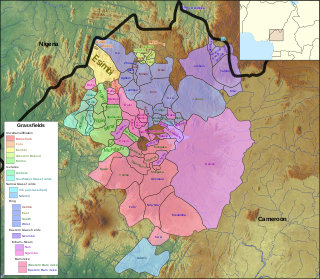Approximants are speech sounds that involve the articulators approaching each other but not narrowly enough nor with enough articulatory precision to create turbulent airflow. Therefore, approximants fall between fricatives, which do produce a turbulent airstream, and vowels, which produce no turbulence. This class is composed of sounds like and semivowels like and, as well as lateral approximants like.
Click consonants, or clicks, are speech sounds that occur as consonants in many languages of Southern Africa and in three languages of East Africa. Examples familiar to English-speakers are the tut-tut or tsk! tsk! used to express disapproval or pity, the tchick! used to spur on a horse, and the clip-clop! sound children make with their tongue to imitate a horse trotting. However, these paralinguistic sounds in English are not full click consonants, as they only involve the front of the tongue, without the release of the back of the tongue that is required for clicks to combine with vowels and form syllables.
Labial consonants are consonants in which one or both lips are the active articulator. The two common labial articulations are bilabials, articulated using both lips, and labiodentals, articulated with the lower lip against the upper teeth, both of which are present in English. A third labial articulation is dentolabials, articulated with the upper lip against the lower teeth, normally only found in pathological speech. Generally precluded are linguolabials, in which the tip of the tongue contacts the posterior side of the upper lip, making them coronals, though sometimes, they behave as labial consonants.
Non-native pronunciations of English result from the common linguistic phenomenon in which non-native speakers of any language tend to transfer the intonation, phonological processes and pronunciation rules of their first language into their English speech. They may also create innovative pronunciations not found in the speaker's native language.
Labialization is a secondary articulatory feature of sounds in some languages. Labialized sounds involve the lips while the remainder of the oral cavity produces another sound. The term is normally restricted to consonants. When vowels involve the lips, they are called rounded.
Hopi is a Uto-Aztecan language spoken by the Hopi people of northeastern Arizona, United States.
The voiced labial–velar approximant is a type of consonantal sound, used in certain spoken languages, including English. It is the sound denoted by the letter ⟨w⟩ in the English alphabet; likewise, the symbol in the International Phonetic Alphabet that represents this sound is ⟨w⟩, or rarely, and the equivalent X-SAMPA symbol is w. In most languages it is the semivocalic counterpart of the close back rounded vowel. In inventory charts of languages with other labialized velar consonants, will be placed in the same column as those consonants. When consonant charts have only labial and velar columns, may be placed in the velar column, (bi)labial column, or both. The placement may have more to do with phonological criteria than phonetic ones.
In phonetics, vowel roundedness is the amount of rounding in the lips during the articulation of a vowel. It is labialization of a vowel. When a rounded vowel is pronounced, the lips form a circular opening, and unrounded vowels are pronounced with the lips relaxed. In most languages, front vowels tend to be unrounded, and back vowels tend to be rounded. However, some languages, such as French, German and Icelandic, distinguish rounded and unrounded front vowels of the same height, and Vietnamese distinguishes rounded and unrounded back vowels of the same height. Alekano has only unrounded vowels. In the International Phonetic Alphabet vowel chart, rounded vowels are the ones that appear on the right in each pair of vowels. There are also diacritics, U+0339◌̹COMBINING RIGHT HALF RING BELOW and U+031C◌̜COMBINING LEFT HALF RING BELOW, to indicate greater and lesser degrees of rounding, respectively. Thus has less rounding than cardinal, and has more. These diacritics can also be used with unrounded vowels: is more spread than cardinal, and is less spread than cardinal.

Irish phonology varies from dialect to dialect; there is no standard pronunciation of Irish. Therefore, this article focuses on phenomena shared by most or all dialects, and on the major differences among the dialects. Detailed discussion of the dialects can be found in the specific articles: Ulster Irish, Connacht Irish, and Munster Irish.

Mycenaean Greek is the most ancient attested form of the Greek language, on the Greek mainland and Crete in Mycenaean Greece, before the hypothesised Dorian invasion, often cited as the terminus ad quem for the introduction of the Greek language to Greece. The language is preserved in inscriptions in Linear B, a script first attested on Crete before the 14th century BC. Most inscriptions are on clay tablets found in Knossos, in central Crete, as well as in Pylos, in the southwest of the Peloponnese. Other tablets have been found at Mycenae itself, Tiryns and Thebes and at Chania, in Western Crete. The language is named after Mycenae, one of the major centres of Mycenaean Greece.
English phonology is the system of speech sounds used in spoken English. Like many other languages, English has wide variation in pronunciation, both historically and from dialect to dialect. In general, however, the regional dialects of English share a largely similar phonological system. Among other things, most dialects have vowel reduction in unstressed syllables and a complex set of phonological features that distinguish fortis and lenis consonants.
The phonology of Vietnamese features 19 consonant phonemes, with 5 additional consonant phonemes used in Vietnamese's Southern dialect, and 4 exclusive to the Northern dialect. Vietnamese also has 14 vowel nuclei, and 6 tones that are integral to the interpretation of the language. Older interpretations of Vietnamese tones differentiated between "sharp" and "heavy" entering and departing tones. This article is a technical description of the sound system of the Vietnamese language, including phonetics and phonology. Two main varieties of Vietnamese, Hanoi and Saigon, which are slightly different to each other, are described below.
The phonological system of the Polish language is similar in many ways to those of other Slavic languages, although there are some characteristic features found in only a few other languages of the family, such as contrasting postalveolar and alveolo-palatal fricatives and affricates. The vowel system is relatively simple, with just six oral monophthongs and arguably two nasals in traditional speech, while the consonant system is much more complex.
This article is a technical description of the phonetics and phonology of Korean. Unless otherwise noted, statements in this article refer to South Korean standard language based on the Seoul dialect.
The phonology of Sesotho and those of the other Sotho–Tswana languages are radically different from those of "older" or more "stereotypical" Bantu languages. Modern Sesotho in particular has very mixed origins inheriting many words and idioms from non-Sotho–Tswana languages.
Iaai is a language of Ouvéa Island. It shares the island of Ouvéa with Fagauvea, a Polynesian outlier language.
This article is about the sound system of the Navajo language. The phonology of Navajo is intimately connected to its morphology. For example, the entire range of contrastive consonants is found only at the beginning of word stems. In stem-final position and in prefixes, the number of contrasts is drastically reduced. Similarly, vowel contrasts found outside of the stem are significantly neutralized. For details about the morphology of Navajo, see Navajo grammar.
A labio-palatalized sound is one that is simultaneously labialized and palatalized. Typically the roundedness is compressed, like, rather than protruded like. The symbol in the International Phonetic Alphabet for this secondary articulation is ⟨ᶣ⟩, a superscript ⟨ɥ⟩, the symbol for the labialized palatal approximant. If such sounds pattern with other, labialized, consonants, they may instead be transcribed as palatalized consonants plus labialization, ⟨ʷ⟩, as with the = of Abkhaz or the = of Akan.

Babanki, or Kejom, is a Bantoid language that is spoken by the Babanki people of the Western Highlands of Cameroon.
Gumuz is a dialect cluster spoken along the border of Ethiopia and Sudan. It has been tentatively classified within the Nilo-Saharan family. Most Ethiopian speakers live in Kamashi Zone and Metekel Zone of the Benishangul-Gumuz Region, although a group of 1,000 reportedly live outside the town of Welkite. The Sudanese speakers live in the area east of Er Roseires, around Famaka and Fazoglo on the Blue Nile, extending north along the border. Dimmendaal et al. (2019) suspect that the poorly attested varieties spoken along the river constitute a distinct language, Kadallu.


